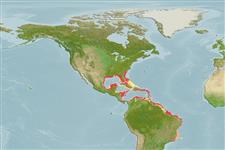Common names from other countries
Environment: milieu / climate zone / depth range / distribution range
Ökologie
seewasser riff-verbunden; tiefenbereich 0 - 75 m (Ref. 5217), usually 18 - ? m (Ref. 51183). Tropical; 33°N - 23°S, 98°W - 34°W (Ref. 34024)
Western Atlantic: North Carolina, USA and northern Gulf of Mexico to southeastern Brazil. Absent from the Bahamas.
Size / Gewicht / Alter
Maturity: Lm ? range ? - ? cm
Max length : 30.0 cm TL Männchen/unbestimmt; (Ref. 7251); common length : 23.0 cm TL Männchen/unbestimmt; (Ref. 5217)
Kurzbeschreibung
Bestimmungsschlüssel | Morphologie | Morphometrie
Head and body tan, unmarked except for dark margin to dorsal fin and, occasionally, anal fin; gill raker on first arch with 2 rudiments on upper limb; dorsal profile nearly straight from snout to dorsal-fin origin (not arched); body distinctly deepest at dorsal-fin origin; body slab-sided (Ref. 34024).
A common species ranging from coastal bays to 75 m depth (Ref. 34024). Inhabit soft bottoms (Ref. 5217). Oviparous, with oval pelagic eggs floating in a gelatinous mass (Ref. 205). Flesh is appreciated (Ref. 5217).
Life cycle and mating behavior
Maturities | Fortpflanzung | Spawnings | Egg(s) | Fecundities | Larven
Nielsen, J.G., D.M. Cohen, D.F. Markle and C.R. Robins, 1999. Ophidiiform fishes of the world (Order Ophidiiformes). An annotated and illustrated catalogue of pearlfishes, cusk-eels, brotulas and other ophidiiform fishes known to date. FAO Fish. Synop. 125(18):178p. Rome: FAO. (Ref. 34024)
IUCN Rote Liste Status (Ref. 130435)
CITES (Ref. 128078)
Not Evaluated
Bedrohung für Menschen
Harmless
Nutzung durch Menschen
Fischereien: weniger kommerziell
Tools
Zusatzinformationen
Download XML
Internet Quellen
Estimates based on models
Preferred temperature (Ref.
115969): 23.2 - 27.9, mean 25.7 (based on 202 cells).
Phylogenetic diversity index (Ref.
82804): PD
50 = 0.5000 [Uniqueness, from 0.5 = low to 2.0 = high].
Bayesian length-weight: a=0.00257 (0.00122 - 0.00544), b=3.17 (2.99 - 3.35), in cm Total Length, based on LWR estimates for this (Sub)family-body shape (Ref.
93245).
Trophic level (Ref.
69278): 3.6 ±0.7 se; based on size and trophs of closest relatives
Widerstandsfähigkeit (Ref.
120179): hoch, Verdopplung der Population dauert weniger als 15 Monate. (Preliminary K or Fecundity.).
Fishing Vulnerability (Ref.
59153): Low vulnerability (20 of 100).
